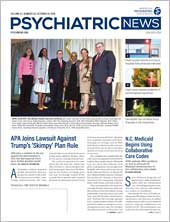Between 48.5 and 64.9 hospital inpatient suicides occur each year in the United States, according to a report in the September Joint Commission Journal on Quality and Patient Safety.
That’s “far below the widely cited figure of 1,500 per year,” wrote lead author Scott Williams, Psy.D., director of the Department of Research at The Joint Commission, and colleagues.
“The results from this study provide a more reliable benchmark of the national inpatient suicide rate for policymakers, regulators, accrediting organizations, health care providers, and researchers to use when making decisions regarding allocation of resources and implementation of specific requirements to prevent inpatient suicides,” they wrote.
The authors analyzed data from 27 states reporting to the National Violent Death Reporting System (NVDRS) for 2014 to 2015 and from hospitals reporting to The Joint Commission’s Sentinel Event (SE) Database from 2010 to 2017. The Centers for Disease Control and Prevention established the NVDRS in 2002 as a population-based surveillance system to quantify deaths by violence and categorize them by cause.
Deaths due to violence are defined by the World Health Organization as “the intentional use of physical force or power against oneself, another person, or against a group or community.”
The sentinel event (SE) database includes data on the suicide of patients who received care in a setting that is staffed around the clock or who died by suicide within 72 hours of discharge, including from the hospital’s emergency department (ED).
Reports to the SE database include coded information about the method of suicide (asphyxiation, hanging, gunshot, drug overdose, jumping from a height, jumping in front of a vehicle, laceration, other). Narrative descriptions from the NVDRS were reviewed and classified using the same categories, whenever the method was clearly indicated in the report.
Here are the report’s main findings:
•
From the states reporting to the NVDRS in 2014, there were 16 inpatient suicides, 11 of which were associated with psychiatric hospitalization. In 2015 there were 30 inpatient suicides reported, 23 of which were associated with psychiatric hospitalization.
•
Extrapolating from the 18 states that reported to the NVDRS in 2014, representing 33 percent of all hospital admissions, the authors estimated that 48.5 inpatient suicides occurred in the United States. Based on the larger set of data available from 27 states in 2015, representing 46.2 percent of all hospital admissions, they estimated that 64.9 inpatient suicides occurred in the United States.
•
A total of 174 inpatient suicides were reported to the SE Database from 2010 to 2016.
•
Hanging was by far the most common method of inpatient suicide in the NVDRS and SE databases (71.7 percent and 70.3 percent, respectively).
“This study provides the first data-driven estimate of the number of inpatient suicides per year in hospitals in the United States,” Williams and colleagues wrote. “The estimated range of 48.5 to 64.9 inpatient suicides per year is vastly lower than the most widely quoted figure of 1,500 per year, which appears to have been based on speculation. … This new, lower estimate of the rate of suicides in hospitals has important implications for the allocation of resources to address suicide prevention within health care and the broader population.
“Because the vast majority of suicides continue to be by hanging, with the most common ligature fixation points being a door, door handle, or door hinge, hospitals should conduct careful environmental assessments to ensure that door handles and door hinges are ‘ligature resistant.’”
Last year administrators at many hospitals expressed concern about increased monitoring and enforcement of citations by the Centers for Medicare and Medicaid Services (CMS) and The Joint Commission around elimination of ligature risks that were costing facilities exorbitant amounts of money. At the July meeting of the APA Board of Trustees, APA CEO and Medical Director Saul Levin, M.D., M.P.A., reported that APA had surveyed 88 facilities in 34 states and the District of Columbia between April and June. Of the 55 that responded, 10 had closed inpatient beds due to the assessment of fines for ligature risks, and 14 had closed psychiatric beds. Twenty-three facilities reported paying fines between $100 and $6 million.
Levin said that APA is continuing to work with CMS and The Joint Commission on the issue. ■
“Incidence and Method of Suicide in Hos-pitals in the United States” can be accessed
here.

